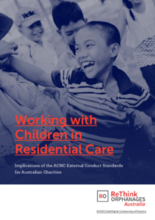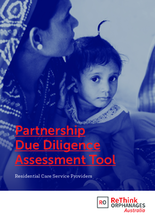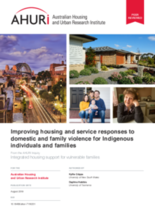Displaying 241 - 250 of 595
This guidance note was developed by ReThink Orphanages Australia and the ACFID Child Rights Community of Practice to assist charities with overseas activities involving residential care for children in their efforts to comply with the Australian Charities and Not for Profit Commission (ACNC)’s External Conduct Standards (ECS).
The Partner Due Diligence Assessment Tool was developed specifically for charities seeking to partner with overseas organisations who provide residential care services for children. It is designed to help you determine whether your partner or prospective partner is operating in accordance with standard notions of good practice and international norms.
According to this research, the unintended consequences of limited housing pathways puts Indigenous women at significant risk of having their children removed by Child Protection. The research examines how housing and other service responses need to be improved to meet the needs of Aboriginal individuals and families in the aftermath of domestic and family violence.
The aim of this study was to describe lifetime involvement in child protection system (CPS) in South Australia, by type of contact.
For this study, a general sample of the New South Wales (NSW) public completed an online survey about adoption practices and their willingness to consider adopting from out-of-home care, with background questions on perceived social support and life satisfaction.
This article from ABC News highlights the growing calls in Australia for backpackers and young people traveling abroad "to rethink volunteering in developing countries as a booming trend of 'voluntourism' exposes a darker side of the industry."
This article describes how the disconnect experienced by Aboriginal children removed from their families and communities in Australia is understood as a dysphoria holding both body-focused aspects and cultural aspects.
The aim of the study was to examine sex differences in self‐reported psychological distress, behavioural and emotional problems, and substance use in young people living in out‐of‐home care (OoHC) in metropolitan Melbourne, Australia.
This qualitative research asked case managers in the Western Australia's child protection system what contributed to timely reunification of children with their families, a recent policy goal.
This paper explores foster carers’ therapeutic capacities and considers some key implications for fostering agencies.



